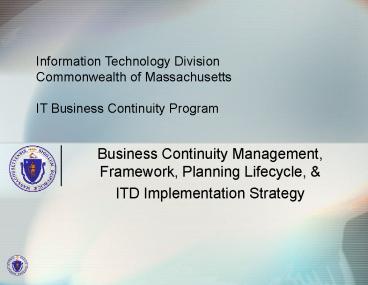Business Continuity Management, Framework, Planning Lifecycle, - PowerPoint PPT Presentation
1 / 11
Title:
Business Continuity Management, Framework, Planning Lifecycle,
Description:
... Framework, Planning Lifecycle, & ITD Implementation Strategy ... Provide a framework for the type of Business Continuity services ITD offers to Agencies ... – PowerPoint PPT presentation
Number of Views:157
Avg rating:3.0/5.0
Title: Business Continuity Management, Framework, Planning Lifecycle,
1
- Business Continuity Management, Framework,
Planning Lifecycle, - ITD Implementation Strategy
2
Objectives
- To establish a framework for a policy governing
Business Continuity Planning for the Commonwealth
of Massachusetts - Provide a framework for the type of Business
Continuity services ITD offers to Agencies
2
3
Business Continuity Planning Lifecycle
Step 2 Conduct Business Impact Analysis Risk
Assessment
Step 1 Initiate Business Continuity Program
Step 3 Develop Recovery Strategies
Step 4 Document Business Continuity Plan
Step 6 Update Business Continuity Plan
Step 5 Test Business Continuity Plan
- The Business Continuity Planning Lifecycle is
comprised of 6 steps, guiding coordinators in
through their planning efforts. - The methodology follows industry best practices
as described by DRII and ITIL. - Business Continuity is not a one-time project it
is an ongoing program that will mature over time.
4
Step 1 Initiate Business Continuity Program
- Obtain executive sponsorship
- Educate management stakeholders on BC
- Gain approvals and support
- Review roles and responsibilities
- Agency Steering Committee
- Plan owner
- Understand the agencys current state of BC
readiness and prior work efforts - Create BCM Project Plan
- Scope
- Timelines
5
Step 2 Conduct Business Impact Analysis Risk
Assessment
- Business Impact Analysis (BIA)
- A process designed to prioritize essential
business functions by assessing quantitative and
qualitative impacts - Identify resource dependencies (e.g., telecom
vital records, staffing, etc) - Recovery Time Objectives (RTO)
- Recovery Point Objectives (RPO)
- Risk Assessment (RA) Process of identifying the
risks probabilities to an organization - Review of potential risks to the business
processes - Review of Technical Infrastructure and data
dependencies - Identify gaps between function RTO technical
RPO
6
Step 3 Develop Recovery Strategies
- Identify process recovery strategies based on the
BIA and RA data - Recommend risk mitigation measures
- Develop alternative strategies to meet the agency
RTO/RPO requirements - Prepare cost benefit analysis timeline for
recommended solutions - Evaluate alternative strategies
- Present to Agency Leadership
- Document alternative strategy decisions
7
Step 4 Document Business Continuity Plan
- Document recovery strategies procedures
- Define roles responsibilities
- Scripts and Checklists
- Create activation procedures
- Detail Communication / Notification procedures
- Establish command and control requirements
8
Step 5 Test Business Continuity Plan
- No Business Continuity Plan should be considered
complete, unless tested - Testing Objectives
- Assess the Business Continuity Teams ability to
respond. - Clarify roles and responsibilities of Team
members - Ensure agency Business Continuity Plans contain
appropriate information and instructions. - Conduct post-exercise evaluation to identify and
share lessons learned opportunities for
improvement
9
Step 6 Update Maintain Business Continuity
Plan
- Business Continuity Plans are updated as
appropriate based on lessons learned from
exercises, real events requiring plan activation,
essential process changes and team member
updates. - Republish and distribute updated Plans to
appropriate stakeholders - Regular awareness training for agency staff
10
ITD BCP Implementation Strategy
Step 2 Conduct Business Impact Analysis Risk
Assessment
Step 1 Initiate Business Continuity Program
Step 3 Develop Recovery Strategies
Step 4 Document Business Continuity Plan
Step 6 Update Business Continuity Plan
Step 5 Test Business Continuity Plan
- Phase 1
- (Steps 1 2)
- Business Impact Analysis
- Technical Assessment
- Gap Assessment
- Phase 2
- (Steps 3 4)
- Strategy Selection
- BC Plan Development
- Phase 3
- (Steps 5 6)
- BCP Testing
- Plan Maintenance
- Continue with BCP Program lifecycle maturity
- Turnover to agency for BCP program oversight
11
Definitions
- BC Business Continuity is the ability of an
organization to maintain its viability, while
continuing to provide service and support to its
customers, before, during, and after an event - BIA Business Impact Analysis is a process
designed to prioritize business functions by
assessing the potential impacts that might result
if an organization was to experience a business
interruption - DR - Disaster Recovery is the ability of an
organization to recovery its Information
Technology (IT) resources, i.e., infrastructure,
databases, and applications - ITA Information Technology Assessment is the
process of identifying dependent critical
applications and IT infrastructure and
determining if their RTOs align with the business
function RTO - RTO Recovery Time Objective is period of time
within which systems, applications, or functions
must be recovered after a business interruption - RPO Recovery Point Objective is the maximum
amount of data loss an agency can sustain during
as a result of an event
11































